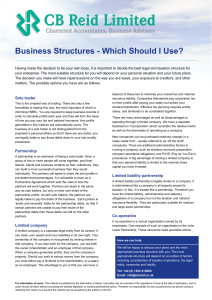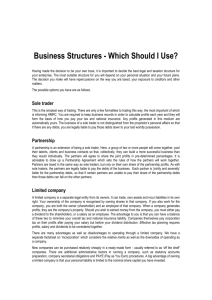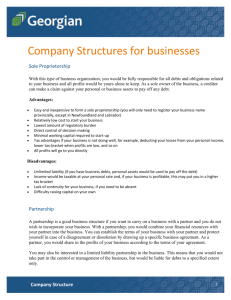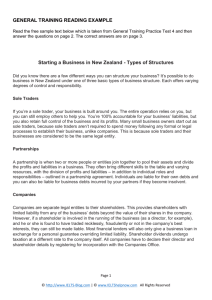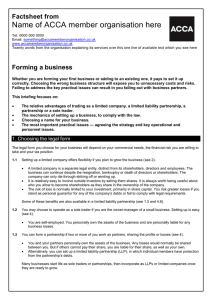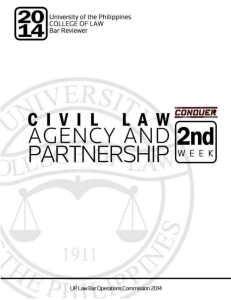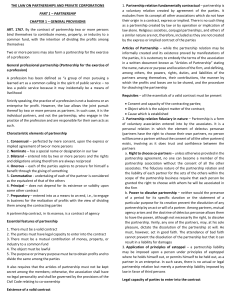SOLE PROPRIETORSHIPS
advertisement
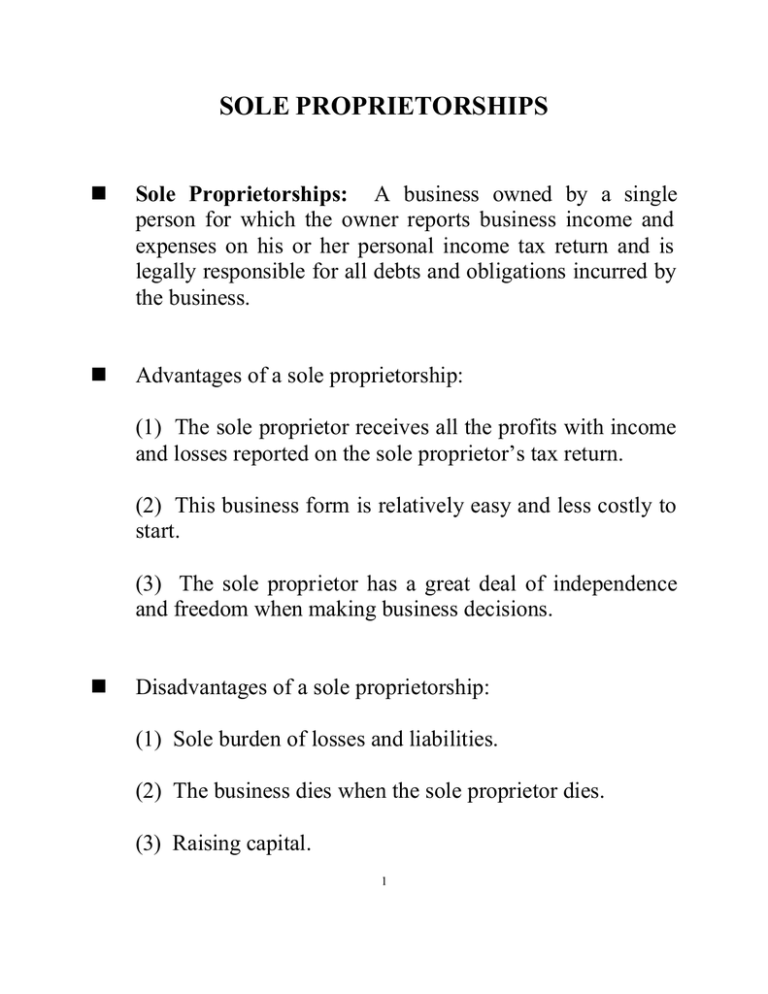
SOLE PROPRIETORSHIPS n Sole Proprietorships: A business owned by a single person for which the owner reports business income and expenses on his or her personal income tax return and is legally responsible for all debts and obligations incurred by the business. n Advantages of a sole proprietorship: (1) The sole proprietor receives all the profits with income and losses reported on the sole proprietor’s tax return. (2) This business form is relatively easy and less costly to start. (3) The sole proprietor has a great deal of independence and freedom when making business decisions. n Disadvantages of a sole proprietorship: (1) Sole burden of losses and liabilities. (2) The business dies when the sole proprietor dies. (3) Raising capital. 1 PARTNERSHIP: DEFINITION AND STATUS n Partnership: An agreement by two or more persons to carry on, as co-owners, a business for profit. Courts often look to the following to determine whether a partnership exists: (1) sharing of profits and losses; (2) joint ownership of the business; and (3) equal rights in the management of the business. n n The Uniform Partnership Act (“UPA”) provides that “persons,” for purposes of a partnership, includes corporations, although some states’ partnership statutes exclude corporations from owning partnership interests. A partnership, while treated as an aggregate of the individual partners for federal income tax purposes, may be treated as a separate entity for other purposes, such as bringing and defending lawsuits, bankruptcy, and ownership of property. 2 PARTNERSHIP FORMATION n Partnership Agreement: A written agreement -sometimes called “Articles of Partnership” -- that sets forth the rights and obligations of each partner with respect to the partnership. n Partnership Duration: The partnership agreement may specify the duration of the partnership in terms of a date or the completion of some undertaking. n n A partnership whose term is so limited is a partnership for a term. Any dissolution of the partnership prior to the term, without the consent of all of the partners, will leave the partner or partners responsible for the dissolution personally liable for any resulting losses. n A partnership whose agreement is silent as to duration is a partnership at will. Any partner may dissolve the partnership at any time without incurring liability. Partnership by Estoppel: Whenever a third party has reasonably and detrimentally relied on the representation, by a partner, that a non-partner was part of the partnership, the non-partner is deemed to be the partnership’s agent and the partnership is liable for his or her acts. 3 PARTNERSHIP INTEREST n Partnership Interest: An individual partner’s personal asset consisting of a proportionate share of the profits earned and a return of initially invested capital upon termination. The UPA provides that in the absence of an agreement, profits are to be split equally and losses are to be shared in the same ratio as profits. n Assignment of Partnership Interest: A partner may assign his or her interest in the partnership to another party, who will then be entitled to receive the partner’s share of profits and, upon termination, the partner’s capital contribution. However, the assignee does not become a partner, and thus has no say in management and no right to inspect the partnership’s books. n Lien on Partnership Interest: A partner’s interest may also be subject to a judgment creditor’s lien. If so, the judgment creditor may obtain a charging order which will entitle the judgment creditor to the partner’s share of profits and, upon termination, the partner’s capital contribution. 4 PARTNERSHIP COMPENSATION n Compensation: Generally speaking, partners do not receive a salary for any work they do for the benefit of the partnership; rather, they are paid a share of the partnership’s profits. However, the partnership can agree otherwise. 5 MANAGEMENT & VOTING RIGHTS n Under the UPA: (1) all partners have equal management rights; (2) each partner has an equal vote, regardless of the relative size of his or her capital contribution; and (3) partnership decisions require a majority vote of the partnership, unless otherwise agreed, except in the following cases, which require unanimous consent: (a) altering the essential nature of the partnership’s business or to alter the capital structure of the partnership; (b) admitting new partners or altering the capital structure of the partnership; (c) assigning partnership property into a trust for the benefit of creditors, disposing of goodwill, or undertaking any act that would make conduct of the partnership’s business impossible; (d) confessing judgment against the partnership; or (e) amending the partnership agreement. 6 ACCOUNTING RIGHTS n n Partnership Books: Partnership books and records must be kept accessible to all partners. n Each partner has the right to receive, and each partner has a corresponding duty to produce, full and complete information concerning the conduct of all aspects of partnership business. n Right to Inspect and Copy: Every partner, whether active or inactive, is entitled to inspect all books and records on demand and may copy any materials. A partner can demand a formal accounting of the partnership’s assets when: (1) provided for in the partnership agreement; (2) a partner is wrongfully denied access to the business and/or the partnership’s books; (3) another partner has breached his or her fiduciary duties to the partnership; or (4) “just and reasonable cause.” 7 PARTNERSHIP DUTIES AND AUTHORITY n n Fiduciary Duties: Partners stand in a fiduciary relationship to one another just as principals and agents do. n Each partner has a duty to act in good faith and for the benefit of the partnership. n Each partner must also subordinate his or her personal interests to those of the partnership. Authority of Partners: Each partner is an agent of the partnership and of each other partner; therefore, agency concepts of actual and apparent authority and ratification apply to acts of a partner. n Any act within the scope of a partner’s authority binds the partnership. n The knowledge of one partner regarding partnership affairs is imputed to all other partners. 8 PARTNERSHIP LIABILITY n Joint Liability: All partners incur joint liability for partnership obligations and debts. However, a partner is not liable for his or her partner’s personal debts. n Joint and Several Liability: Some states permit a plaintiff to sue one or more individual partners, and to collect a judgment arising from the partnership’s acts or omissions from one or more of the individual partners. n Incoming Partners: Newly-admitted partners are liable for debts and obligations incurred before they joined the partnership only to the extent of their capital contribution. 9 PARTNERSHIP DISSOLUTION n Dissolution: The formal disbanding of a partnership, which can be brought about by: (1) the terms of the partnership agreement; (2) voluntary or involuntary withdrawal; (3) the addition of one or more new partners; (4) death of a partner; (5) bankruptcy of a partner or of the partnership; or (6) judicial decree. 10 PARTNERSHIP WINDING UP n Winding Up: Once dissolution is formalized and notice has been given to all partners and all creditors of the partnership, the partners are only authorized to (i) complete transactions begun but not completed as of the dissolution and (ii) wind up the partnership’s affairs -- i.e., collect and preserve partnership assets, pay partnership debts, and account to each partner for the value of his or her interest in the partnership. n Partnership assets are distributed in the following order: (1) Outside creditors of the partnership. (2) Debts owed to a partner. (3) Return of capital contribution. (4) Split of the profits. 11

